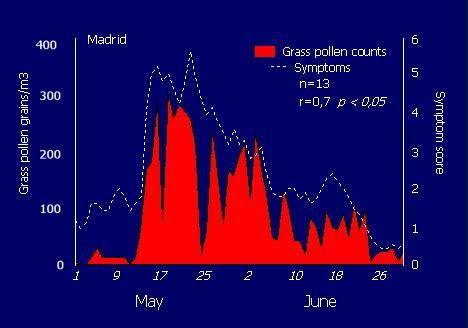Grasses, how to interpret the pollen counts
There are many factors that make it difficult to establish a close correlation between the grass pollen counts and the pollinosis symptoms.
1) The range of severity of the pollinosis is quite broad from patient to patient.
2) Many patients show sensitization to other pollens that pollinate at the same time as grasses (Olea europaea, Plantago, Rumex..).
3) The nasal and bronchial response increases as the season progresses (priming effect).
4) The pollen allergens are also present outside of the pollen as aerosol fractions.
5) Many factors may increase the individual exposure to pollen (driving with the window open or riding a motorcycle...) or their antigens (grass juice aerosol during mowing).
6) The pollen counts may vary depending on the height of collector position and vegetation surroundings).
For these reasons it is not surprising that on some occasions patients find an absence of correlation between the pollen counts and pollinosis symptoms. However when this correlation (symptom-grass pollen count) is considered on the whole, it is very clear (Figure).

A primordial question is if these pollen counts should be shown in absolute numbers or in qualitative terms (low, medium or high). In this sense Frankland and Davies were able to prove that when in their collector they obtained a daily mean grass concentration > of 50 grains/m3 of air, all the patients clinically sensitized to grasses and resident in this area showed -symptoms, considering this concentration as high (not as threshold, since some patients showed symptoms with < 20). Later Danish authors have classified daily mean grass concentrations (grains/m3) as low <10, moderate (between 10-50) and high (> 50).
From our point of view these classifications might be too arbitrary, for the above mentioned reasons. What is low for some can be high for others. An also what is low at the beginning of the season can be high few weeks later due to the priming effect. For this reason it is more logical to show the pollen counts in absolute numbers instead of qualitative terms. In this way the patient can learn which is his personal threshold level. And also recognize when he should start and finish his symptomatic treatment.
Pollen counts are useful for the patient to understand the important interannual variation in the intensity of symptoms and also to plan travel in order to avoid the allergenic pollens.
Furthermore pollen counts can be very useful for doctors to differentiate clinic sensitization from subclinic sensitization in patients.
Other pollens, how to interpret the pollen counts.
With the same limitations as for grasses, the clinic experience seems to indicate that in general sufficient pollen count concentrations to induce symptoms are > 30 grains/m3 of Urticaceae (Parietaria "Pellitory"), > 200 grains/m3 of Olea (olive), > 20 for Ambrosia (ragweed), > 80 for Betula (birch) in susceptible patients.

